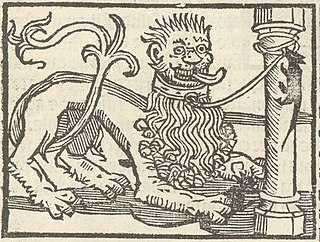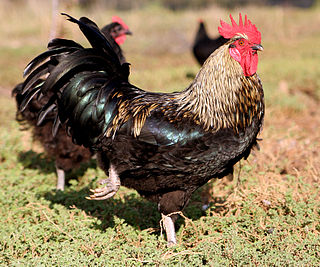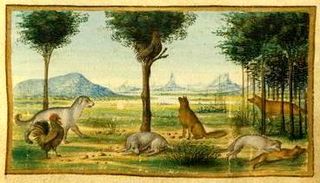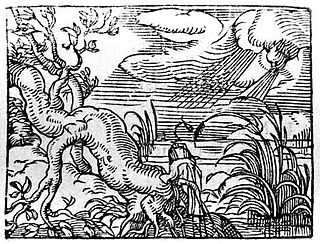
The Bear and the Travelers is a fable attributed to Aesop and is number 65 in the Perry Index. [1] It was expanded and given a new meaning in mediaeval times.

The Bear and the Travelers is a fable attributed to Aesop and is number 65 in the Perry Index. [1] It was expanded and given a new meaning in mediaeval times.
First recorded in Latin verse by Avianus, the tale is one that educators recommend for teaching young children about moral values. [2] The basic story is of two friends walking through rough country who are suddenly confronted by a bear. One of the travellers saves himself by scrambling up a tree while the other throws himself on the ground and pretends to be dead. The animal comes close and sniffs him over but then leaves, for bears are reputed not to touch dead meat. Then the man in the tree came down to his comrade and jokingly asked what the bear had been saying to him. "It was some good advice," said his friend; "he told me never to trust someone who deserts you in need."
Feigning illness or death is a core plot element in several of the fables. [3] Author and San Francisco Examiner journalist Allen Kelly, writing in 1903, examines the idea of 'playing dead' to evade injury when confronted by a bear and gives his opinion that there is some truth in this fable. [4]
The late mediaeval chronicler Philippe de Commynes records that an embassy was sent by King Louis XI of France to the Emperor Frederick III in 1475 with a proposal to divide up the Burgundian territories. [5] The Emperor replied with a story of how three friends obtain credit at an inn by promising to catch a bear and dispose of the skin but are eventually forced to flee; one of them falls to the ground, is sniffed by the bear but then left unharmed. Asked by his friends what the bear had to say, he replied "She charged me never for the future to sell the bear's skin till the beast was dead".
This is one of the earliest references to a proverb now found throughout Europe, 'Catch the bear before you sell his skin'. [6] The heart of the story that the Emperor tells is Aesop's fable, but it has now been adapted to end with the lesson not to count one's chickens before they are hatched. A variation on the story appears in the Neo-Latin author Laurentius Abstemius' collection of a hundred fables (Hecatomythium) written some time in the 1490s. This was titled De Cortario emente pellem Ursi a Venatore nondum capti (How a tanner bought a bear's skin from hunters before it was taken). But it was La Fontaine's Fables that assured the continued popularity of this variation of the tale (V. 20.) [7] His version, L'ours et les deux compagnons, is much the same as that of Philippe de Commynes apart from the detail that only two men are involved, one of whom escapes up a tree (as in Aesop). Aesop, however, had reserved the moral of not anticipating success in an enterprise before it is accomplished for his fable of The Milkmaid and Her Pail.
Because of the connection with La Fontaine, it is in France that one finds the fable most used. Louis Lacombe set it as part of his Opus 72 in 1875. It was made into a nine-minute silent film by the film producer Marius O'Gallop in 1920. The composer Francis Poulenc included it as the second episode in his ballet suite Les Animaux modèles (1941) [8] and it was Plate 63 of the hundred fables illustrated by etchings heightened with watercolour by the artist Marc Chagall (1952). [9]
Among those drawing from Aesop's version, the young Scottish artist Martin Hill produced a large oil painting of the scene in 2009. [10] In 1965 the composer Edward Hughes included the fable in a poetic version by Peter Westmore among his ten Songs from Aesop's Fables. There is also a setting by Anthony Plog for narrator, horn and piano (2011).

Fable is a literary genre defined as a succinct fictional story, in prose or verse, that features animals, legendary creatures, plants, inanimate objects, or forces of nature that are anthropomorphized, and that illustrates or leads to a particular moral lesson, which may at the end be added explicitly as a concise maxim or saying.

Aesop's Fables, or the Aesopica, is a collection of fables credited to Aesop, a slave and storyteller who lived in ancient Greece between 620 and 564 BCE. Of varied and unclear origins, the stories associated with his name have descended to modern times through a number of sources and continue to be reinterpreted in different verbal registers and in popular as well as artistic media.

The Ant and the Grasshopper, alternatively titled The Grasshopper and the Ant, is one of Aesop's Fables, numbered 373 in the Perry Index. The fable describes how a hungry grasshopper begs for food from an ant when winter comes and is refused. The situation sums up moral lessons about the virtues of hard work and planning for the future.
The North Wind and the Sun is one of Aesop's Fables. It is type 298 in the Aarne–Thompson folktale classification. The moral it teaches about the superiority of persuasion over force has made the story widely known. It has also become a chosen text for phonetic transcriptions.

The Monkey and the Cat is best known as a fable adapted by Jean de La Fontaine under the title Le Singe et le Chat that appeared in the second collection of his Fables in 1679 (IX.17). It is the source of popular idioms in both English and French, with the general meaning of being the dupe of another.

The Lion and the Mouse is one of Aesop's Fables, numbered 150 in the Perry Index. There are also Eastern variants of the story, all of which demonstrate mutual dependence regardless of size or status. In the Renaissance the fable was provided with a sequel condemning social ambition.

"The Town Mouse and the Country Mouse" is one of Aesop's Fables. It is number 352 in the Perry Index and type 112 in Aarne–Thompson's folk tale index. Like several other elements in Aesop's fables, "town mouse and country mouse" has become an English idiom.

The Dog and Its Reflection is one of Aesop's Fables and is numbered 133 in the Perry Index. The Greek language original was retold in Latin and in this way was spread across Europe, teaching the lesson to be contented with what one has and not to relinquish substance for shadow. There also exist Indian variants of the story. The morals at the end of the fable have provided both English and French with proverbs and the story has been applied to a variety of social situations.

The Fox and the Crow is one of Aesop's Fables, numbered 124 in the Perry Index. There are early Latin and Greek versions and the fable may even have been portrayed on an ancient Greek vase. The story is used as a warning against listening to flattery.

The Cock and the Jewel is a fable attributed to Aesop and is numbered 503 in the Perry Index. As a trope in literature, the fable is reminiscent of stories used in Zen such as the kōan. It presents, in effect, a riddle on relative values and is capable of different interpretations, depending on the point of view from which it is regarded.
The Ass in the Lion's Skin is one of Aesop's Fables, of which there are two distinct versions. There are also several Eastern variants, and the story's interpretation varies accordingly.

The Fox and the Sick Lion is one of Aesop's Fables, well known from Classical times and numbered 142 in the Perry Index. There is also an Indian analogue. Interpretations of the story's meaning have differed widely in the course of two and a half millennia.

The Wolf and the Lamb is a well-known fable of Aesop and is numbered 155 in the Perry Index. There are several variant stories of tyrannical injustice in which a victim is falsely accused and killed despite a reasonable defence.
The Bear and the Gardener is a fable originating in the ancient Indian text Panchatantra that warns against making foolish friendships. There are several variant versions, both literary and oral, across the world and its folk elements are classed as Aarne-Thompson-Uther type 1586. The La Fontaine version has been taken as demonstrating various philosophical lessons.

The Cock, the Dog and the Fox is one of Aesop's Fables and appears as number 252 in the Perry Index. Although it has similarities with other fables where a predator flatters a bird, such as The Fox and the Crow and Chanticleer and the Fox, in this one the cock is the victor rather than victim. There are also Eastern variants of this story.

The Mountain in Labour is one of Aesop's Fables and appears as number 520 in the Perry Index. The story became proverbial in Classical times and was applied to a variety of situations. It refers to speech acts which promise much but deliver little, especially in literary and political contexts. In more modern times the satirical intention behind the fable was given greater emphasis following Jean de la Fontaine's interpretation of it. Illustrations to the text underlined its ironical application particularly and went on to influence cartoons referring to the fable elsewhere in Europe and America.

The Oak and the Reed is one of Aesop's Fables and is numbered 70 in the Perry Index. It appears in many versions: in some it is with many reeds that the oak converses and in a late rewritten version it disputes with a willow.

The Horse and the Donkey is one of a number of ancient animal fables that illustrate the importance of helping others and the consequences of neglecting that duty.

The Frog and the Mouse is one of Aesop's Fables and exists in several versions. It is numbered 384 in the Perry Index. There are also Eastern versions of uncertain origin which are classified as Aarne-Thompson type 278, concerning unnatural relationships. The stories make the point that the treacherous are destroyed by their own actions.
There are no less than six fables concerning an impertinent insect, which is taken in general to refer to the kind of interfering person who makes himself out falsely to share in the enterprise of others or to be of greater importance than he is in reality. Some of these stories are included among Aesop's Fables, while others are of later origin, and from them have been derived idioms in several languages.